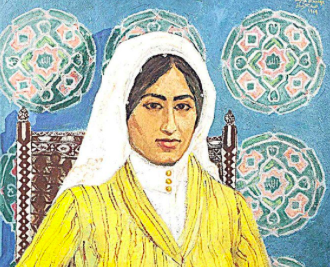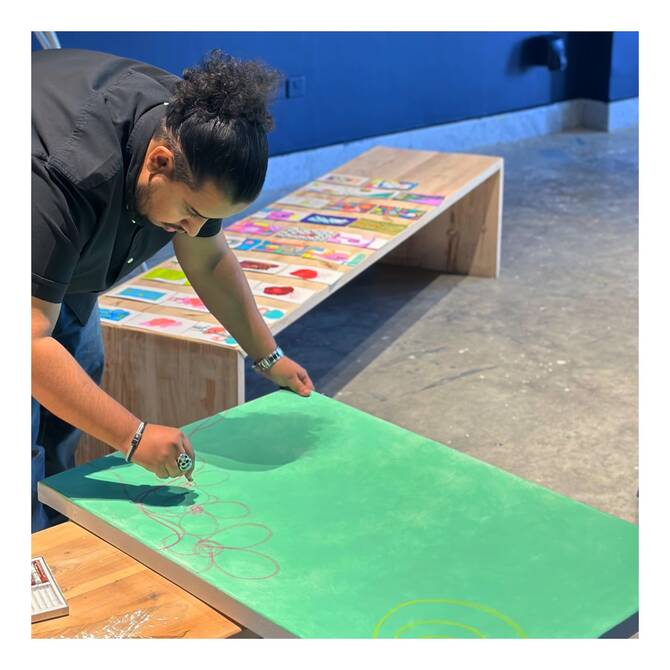Ruba Obaid
JEDDAH: Saudi society has experienced tremendous developments over the past few decades, driven by successive development plans, which played a major role in driving social change and empowering women.
Despite the relatively short history of Saudi Arabia’s art movement, art can be used as a tangible source of reflection on the country’s wider social context, particularly when it comes to the status of women.
Saudi researcher Dr. Lama Al-Badna explored the social, political, and economic context through which Saudi women were portrayed in art from the 1960s onward, studying 111 artworks produced by Saudi artists from 1969 to 2019.
Starting with a focus on economic factors and their impact, Al-Badna began with Safeya bint Zager’s prominent piece “The Hijazi Mona Lisa,” or “Al-Zaboon” as it was originally called.
“The importance of this work comes from the fact that it was created by a woman expressing herself as a woman,” Al-Badna told Arab News. “The woman in the artwork appears wearing traditional clothing from Hijaz, Makkah, in a portrait.”
The woman’s presence in different public spaces and in the field of work was a huge empowerment; having an income enabled her to make decisions in her family and change her reality.
Dr. Lama Al-Badna, Saudi researcher
The artwork came during a period when female education had only recently been introduced, six decades after education for boys, and around the time the government launched its first development plan in 1970 following the growth in oil revenue. Development plans played an important role to include women in the public education and health systems, and that is when Saudi women began to realize their capabilities, she added.
“Public education did not start as a purely Saudi experience, but rather derived from Arab experiences with teachers coming from Egypt, the Levantine countries and Sudan,” Al-Badna said.
“Therefore, women, for the first time, had exposure to a much wider horizon which made them realize their potential.
“It is not the consciousness of men that determines their being, but, on the contrary, their social existence that determines their consciousness,” she added, quoting Karl Marx from his “Critique of Political Economy.”

She used Marx’s theory of false consciousness to explain how the Saudi woman started to become aware of her mental, intellectual and physical potential, which allowed her to reach what was once unthinkable due to her status in society.
The woman’s presence in different public spaces and in the field of work was a huge empowerment, having an income enabled her to make decisions in her family and change her reality, she said.
The country’s modernization, driven by development plans, was reflected in how women were portrayed in art throughout decades; although women in traditional wear and settings were always present in artworks, Al-Badna said that their interpretations were not the same.
“Women in traditional costumes was a central theme of artworks from the ‘60s to 2000,” she said. However, the image of the women differed in accordance with ongoing social change, strongly influenced by regional and local events.
The rising conservative sentiment in the region in the aftermath of the Iranian revolution in 1979, as well as unrest caused by the Juhayman Al-Otaibi’s in the Grand Mosque in November that year, were key factors in the dramatic social change which impacted the status and image of Saudi women.
“The artist in the 1960s used to paint portraits of the woman that he saw with his own eyes,” Al-Badna explained. “However, the artist later on painted the woman he evoked in his memory.
Meaning, the first artist was painting his reality, while the second artist was painting the folklore.”
The obsession with folklore was either an attempt to circumvent women’s absence from public places, or an escape from modernity.

In the 1980s until 2000, the mental image of Saudi women’s faces was usually blurry and ambiguous due to their absence in the media and cultural scene, and the way they were covered in public places, she explained.
“During that period, when a man painted women, he didn’t portray the Saudi woman. Rather, I argue, he painted the woman he used to see in magazines and on television, which was not Saudi,” said Al-Badna.
Female artists, on the other hand, had a more authentic expression of women’s reality.
From 2010 onward, Saudi women boldly expressed themselves and became more direct in addressing their struggles and problems with society; they also shifted from the passive expression of their own sorrows to addressing issues related to their reality, Al-Badna said.
The rise of social media also played a major role in raising the ceiling of expression.
Artist Taghreed Al-Bugshi portrayed a woman driving a motorcycle with a plate that has the letters of the word “drive” in Arabic, while in another painting she made a woman sit on top of a car.
“The woman appeared hovering around the car but was unable to sit in the driver’s seat; (the work) was expressing this sense of constraint,” said Al-Badnah.
After women won the right to drive in 2018, the same artist painted women in the driving seat with their license plates showing the word “determination.”
In his book “Changing Saudi Arabia: Art, Culture & Society in the Kingdom,” Sean Foley argued that artists’ role in Saudi society is similar to Antonio Gramsci’s concept of organic intellectuals.
“Saudi artists are not part of the society’s traditional intellectual elite, but through the language of their culture, they articulate feelings and experiences that the masses cannot easily express,” Foley said.
Like Foley, Al-Badna saw female artists, especially through their sense of solidarity as they reflected reality and their struggle with it, advocated cultural and social change that is consistent with global norms in the 21st century.
Nonetheless, Al-Badna strongly stressed that governmental plans were the main driver of social change, and governmental support in recent years has played a key role in allowing the Kingdom’s art scene to flourish. The numerous initiatives by the Ministry of Culture to support the country’s cultural scene, including the arts, were essential to grow social interest and drive growth in numbers of Saudi artists in different types of art since 2019.
“Women especially appeared ready for all upcoming change; an artwork by artist Najlaa Al-Salim in 2019 pictured the shadows of many women and the title of her painting was ‘aptitude,’” said Al-Badnah.
“One of the factors that led to the decline of art and the restriction of artists in the past was the social force of opposition, and this social force opposed television and education, as well as cultural activities, including art,” she explained.
Nonetheless, despite art’s long exclusion in the Kingdom, Saudi Arabia is currently exerting efforts to be the home of the most vibrant artistic movements in the Middle East today.






















